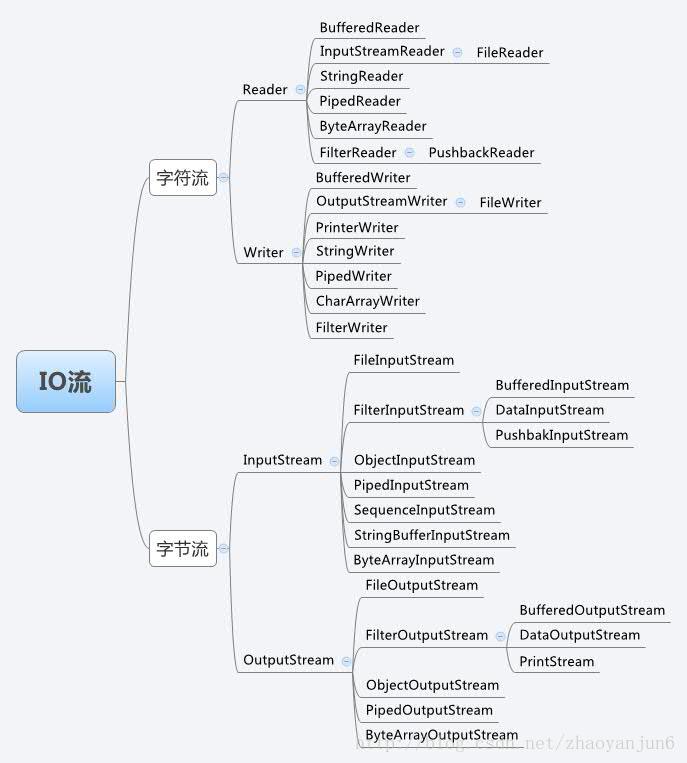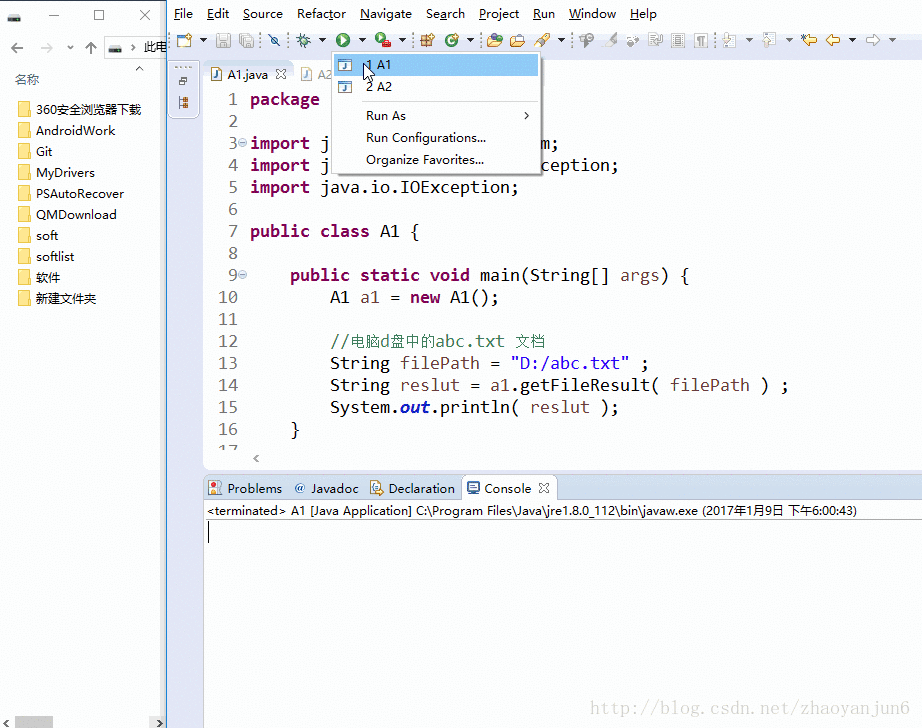Java IO流学习总结一:输入输出流
2018-08-05 07:45:43来源:博客园 阅读 ()

转载请标明出处:http://blog.csdn.net/zhaoyanjun6/article/details/54292148
本文出自【赵彦军的博客】
Java流类图结构:

流的概念和作用
流是一组有顺序的,有起点和终点的字节集合,是对数据传输的总称或抽象。即数据在两设备间的传输称为流,流的本质是数据传输,根据数据传输特性将流抽象为各种类,方便更直观的进行数据操作。
IO流的分类
- 根据处理数据类型的不同分为:字符流和字节流
- 根据数据流向不同分为:输入流和输出流
字符流和字节流
字符流的由来: 因为数据编码的不同,而有了对字符进行高效操作的流对象。本质其实就是基于字节流读取时,去查了指定的码表。 字节流和字符流的区别:
- 读写单位不同:字节流以字节(8bit)为单位,字符流以字符为单位,根据码表映射字符,一次可能读多个字节。
-
处理对象不同:字节流能处理所有类型的数据(如图片、avi等),而字符流只能处理字符类型的数据。
- 字节流:一次读入或读出是8位二进制。
-
字符流:一次读入或读出是16位二进制。
设备上的数据无论是图片或者视频,文字,它们都以二进制存储的。二进制的最终都是以一个8位为数据单元进行体现,所以计算机中的最小数据单元就是字节。意味着,字节流可以处理设备上的所有数据,所以字节流一样可以处理字符数据。
结论:只要是处理纯文本数据,就优先考虑使用字符流。 除此之外都使用字节流。
输入流和输出流
输入流只能进行读操作,输出流只能进行写操作,程序中需要根据待传输数据的不同特性而使用不同的流。
输入字节流 InputStream
InputStream是所有的输入字节流的父类,它是一个抽象类。ByteArrayInputStream、StringBufferInputStream、FileInputStream是三种基本的介质流,它们分别从Byte 数组、StringBuffer、和本地文件中读取数据。PipedInputStream是从与其它线程共用的管道中读取数据,与Piped 相关的知识后续单独介绍。ObjectInputStream和所有FilterInputStream的子类都是装饰流(装饰器模式的主角)。
输出字节流 OutputStream
OutputStream是所有的输出字节流的父类,它是一个抽象类。ByteArrayOutputStream、FileOutputStream是两种基本的介质流,它们分别向Byte 数组、和本地文件中写入数据。PipedOutputStream是向与其它线程共用的管道中写入数据。ObjectOutputStream和所有FilterOutputStream的子类都是装饰流。
总结:
- 输入流:InputStream或者Reader:从文件中读到程序中;
- 输出流:OutputStream或者Writer:从程序中输出到文件中;
节点流
节点流:直接与数据源相连,读入或读出。
直接使用节点流,读写不方便,为了更快的读写文件,才有了处理流。
常用的节点流
- 父 类 :
InputStream、OutputStream、Reader、Writer - 文 件 :
FileInputStream、FileOutputStrean、FileReader、FileWriter文件进行处理的节点流 - 数 组 :
ByteArrayInputStream、ByteArrayOutputStream、CharArrayReader、CharArrayWriter对数组进行处理的节点流(对应的不再是文件,而是内存中的一个数组) - 字符串 :
StringReader、StringWriter对字符串进行处理的节点流 - 管 道 :
PipedInputStream、PipedOutputStream、PipedReader、PipedWriter对管道进行处理的节点流
处理流
处理流和节点流一块使用,在节点流的基础上,再套接一层,套接在节点流上的就是处理流。如BufferedReader.处理流的构造方法总是要带一个其他的流对象做参数。一个流对象经过其他流的多次包装,称为流的链接。
常用的处理流
- 缓冲流:
BufferedInputStrean、BufferedOutputStream、BufferedReader、BufferedWriter增加缓冲功能,避免频繁读写硬盘。 - 转换流:
InputStreamReader、OutputStreamReader实现字节流和字符流之间的转换。 - 数据流:
DataInputStream、DataOutputStream等-提供将基础数据类型写入到文件中,或者读取出来。
转换流
InputStreamReader 、OutputStreamWriter 要InputStream或OutputStream作为参数,实现从字节流到字符流的转换。
构造函数
-
InputStreamReader(InputStream); //通过构造函数初始化,使用的是本系统默认的编码表GBK。
-
InputStreamWriter(InputStream,String charSet); //通过该构造函数初始化,可以指定编码表。
-
OutputStreamWriter(OutputStream); //通过该构造函数初始化,使用的是本系统默认的编码表GBK。
-
OutputStreamwriter(OutputStream,String charSet); //通过该构造函数初始化,可以指定编码表。
实战演练
- FileInputStream类的使用:读取文件内容
-
package com.app;
-
-
import java.io.FileInputStream;
-
import java.io.FileNotFoundException;
-
import java.io.IOException;
-
-
public class A1 {
-
-
public static void main(String[] args) {
-
A1 a1 = new A1();
-
-
//电脑d盘中的abc.txt 文档
-
String filePath = "D:/abc.txt" ;
-
String reslut = a1.readFile( filePath ) ;
-
System.out.println( reslut );
-
}
-
-
-
/**
-
* 读取指定文件的内容
-
* @param filePath : 文件的路径
-
* @return 返回的结果
-
*/
-
public String readFile( String filePath ){
-
FileInputStream fis=null;
-
String result = "" ;
-
try {
-
// 根据path路径实例化一个输入流的对象
-
fis = new FileInputStream( filePath );
-
-
//2. 返回这个输入流中可以被读的剩下的bytes字节的估计值;
-
int size = fis.available() ;
-
//3. 根据输入流中的字节数创建byte数组;
-
byte[] array = new byte[size];
-
//4.把数据读取到数组中;
-
fis.read( array ) ;
-
-
//5.根据获取到的Byte数组新建一个字符串,然后输出;
-
result = new String(array);
-
-
} catch (FileNotFoundException e) {
-
e.printStackTrace();
-
}catch (IOException e) {
-
e.printStackTrace();
-
}finally{
-
if ( fis != null) {
-
try {
-
fis.close();
-
} catch (IOException e) {
-
e.printStackTrace();
-
}
-
}
-
}
-
-
return result ;
-
}
-
-
-
}
-
- FileOutputStream 类的使用:将内容写入文件
-
package com.app;
-
import java.io.FileNotFoundException;
-
import java.io.FileOutputStream;
-
import java.io.IOException;
-
-
public class A2 {
-
-
public static void main(String[] args) {
-
A2 a2 = new A2();
-
-
//电脑d盘中的abc.txt 文档
-
String filePath = "D:/abc.txt" ;
-
-
//要写入的内容
-
String content = "今天是2017/1/9,天气很好" ;
-
a2.writeFile( filePath , content ) ;
-
-
}
-
-
/**
-
* 根据文件路径创建输出流
-
* @param filePath : 文件的路径
-
* @param content : 需要写入的内容
-
*/
-
public void writeFile( String filePath , String content ){
-
FileOutputStream fos = null ;
-
try {
-
//1、根据文件路径创建输出流
-
fos = new FileOutputStream( filePath );
-
-
//2、把string转换为byte数组;
-
byte[] array = content.getBytes() ;
-
//3、把byte数组输出;
-
fos.write( array );
-
-
} catch (FileNotFoundException e) {
-
e.printStackTrace();
-
}catch (IOException e) {
-
e.printStackTrace();
-
}finally{
-
if ( fos != null) {
-
try {
-
fos.close();
-
} catch (IOException e) {
-
e.printStackTrace();
-
}
-
}
-
}
-
}
-
-
-
}
注意:
- 在实际的项目中,所有的IO操作都应该放到子线程中操作,避免堵住主线程。
FileInputStream在读取文件内容的时候,我们传入文件的路径("D:/abc.txt"), 如果这个路径下的文件不存在,那么在执行readFile()方法时会报FileNotFoundException异常。FileOutputStream在写入文件的时候,我们传入文件的路径("D:/abc.txt"), 如果这个路径下的文件不存在,那么在执行writeFile()方法时, 会默认给我们创建一个新的文件。还有重要的一点,不会报异常。
效果图:

- 综合练习,实现复制文件,从D盘复制到E盘
-
package com.app;
-
import java.io.FileInputStream;
-
import java.io.FileNotFoundException;
-
import java.io.FileOutputStream;
-
import java.io.IOException;
-
-
public class A3 {
-
-
public static void main(String[] args) {
-
A3 a2 = new A3();
-
-
//电脑d盘中的cat.png 图片的路径
-
String filePath1 = "D:/cat.png" ;
-
-
//电脑e盘中的cat.png 图片的路径
-
String filePath2 = "E:/cat.png" ;
-
-
//复制文件
-
a2.copyFile( filePath1 , filePath2 );
-
-
}
-
-
/**
-
* 文件复制
-
* @param filePath_old : 需要复制文件的路径
-
* @param filePath_new : 复制文件存放的路径
-
*/
-
public void copyFile( String filePath_old , String filePath_new){
-
FileInputStream fis=null ;
-
FileOutputStream fout = null ;
-
try {
-
// 根据path路径实例化一个输入流的对象
-
fis = new FileInputStream( filePath_old );
-
-
//2. 返回这个输入流中可以被读的剩下的bytes字节的估计值;
-
int size = fis.available() ;
-
//3. 根据输入流中的字节数创建byte数组;
-
byte[] array = new byte[size];
-
//4.把数据读取到数组中;
-
fis.read( array ) ;
-
-
//5、根据文件路径创建输出流
-
fout = new FileOutputStream( filePath_new ) ;
-
-
//5、把byte数组输出;
-
fout.write( array );
-
-
} catch (FileNotFoundException e) {
-
e.printStackTrace();
-
}catch (IOException e) {
-
e.printStackTrace();
-
}finally{
-
if ( fis != null) {
-
try {
-
fis.close();
-
} catch (IOException e) {
-
e.printStackTrace();
-
}
-
}
-
if ( fout != null ) {
-
try {
-
fout.close();
-
} catch (IOException e) {
-
e.printStackTrace();
-
}
-
}
-
}
-
}
-
标签:
版权申明:本站文章部分自网络,如有侵权,请联系:west999com@outlook.com
特别注意:本站所有转载文章言论不代表本站观点,本站所提供的摄影照片,插画,设计作品,如需使用,请与原作者联系,版权归原作者所有
- 国外程序员整理的Java资源大全(全部是干货) 2020-06-12
- 2020年深圳中国平安各部门Java中级面试真题合集(附答案) 2020-06-11
- 2020年java就业前景 2020-06-11
- 04.Java基础语法 2020-06-11
- Java--反射(框架设计的灵魂)案例 2020-06-11
IDC资讯: 主机资讯 注册资讯 托管资讯 vps资讯 网站建设
网站运营: 建站经验 策划盈利 搜索优化 网站推广 免费资源
网络编程: Asp.Net编程 Asp编程 Php编程 Xml编程 Access Mssql Mysql 其它
服务器技术: Web服务器 Ftp服务器 Mail服务器 Dns服务器 安全防护
软件技巧: 其它软件 Word Excel Powerpoint Ghost Vista QQ空间 QQ FlashGet 迅雷
网页制作: FrontPages Dreamweaver Javascript css photoshop fireworks Flash
